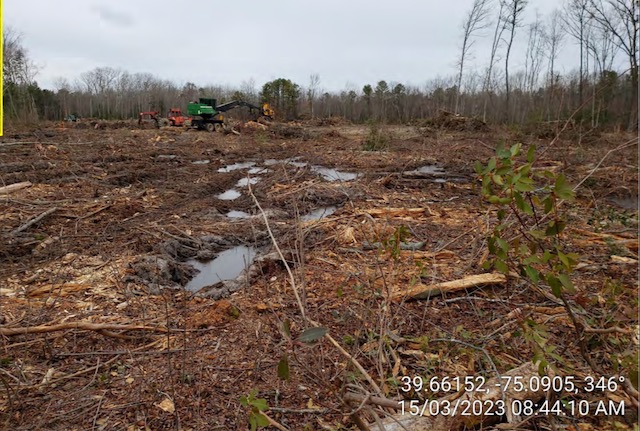Creation of Habitat and Promotion of Hunting Reach Their End Game
“Active Management”, “Thinning”, “Feathering”, & “Treatments” Go Rogue To Clearcut
You have to read the DEP justification below of their clearcut of the Glassboro Wildlife Management Area to create habitat for a game bird. It confirms everything critics have attacked.
For many years, environmental activists across the state have criticized the DEP wildlife and forest management programs for relying on flawed science and elevating narrow special interests (e.g. a single bird species, or creation of habitat for game species to serve hunting interests) above climate science, forest ecology, wildlife science (think bear hunt), and forest preservation. This has led to poor land management, slaughter of animals, and logging of mature forests across the state.
A major substantive focus of this criticism has been on how DEP uses the sham science of creation of habitat to justify logging and the complete lack of regulation of DEP’s management programs, like logging.
A major process criticism focused on how DEP is captured totally by the hunting lobby, whose interests DEP serves. DEP excludes the public and fails to involve the public in DEP public lands and wildlife management. DEP simply ignores public demands.
Prominent conservation groups, like NJ Audubon, have provided cover and support for this sham science and destructive management, see:
If I were to write a parody to illustrate and mock all these problems at DEP – like an Onion piece – I could not have written anything nearly as good as DEP’s actual justification below.
I will expand upon and discus the specifics in a followup post, but here it is in its entirety, unedited, for you to read. (A word of caution: DEP has denied my OPRA requests for all the DEP internal review documents and emails, including exactly how this project went through the DEP review process and management chain, and all the upper level managers who signed off on it. I think that is part of DEP’s attempt to find a fall guy and make this appear like an individual rogue staffer or “mistake”.)
The text below is from a March 6 memo from Tyler Kinney, DEP’s “Regional Habitat Planner”, Bureau of Land Management, Division of Fish and Wildlife, to Don Donnelly of the USDA/NRCS (remarkably, Donnelley is a former NJ Audubon logger). Kinney copies DEP manager Lisa Barno (previously head of DEP Freshwater Fisheries, where she was captured by and served the interests of license fee revenue generating fishermen) and our Sparta Mountain golden wing warbler logger DEP biologist Sharon Petzinger. Kinney was responding to Donnelly’s quite revealing March 3 inquiry (more about that in a followup post) about what went on in Glassboro WMA project: (emphases are mine):
The intention of this project is to create meadow habitat for the purpose of managing for woodcock. According to USFWS, the long term trend in woodcock heard during singing ground surveys is in significant decline in New Jersey. A 2015 study out of Cape May by Allen et al. (attached) suggests this decline is due to changing land use – namely the maturation of abandoned farm land into forests. The study concludes that open habitats (meadows, grasslands) in close proximity to forested wetlands is a key variable in generating suitable woodcock habitat in New Jersey.
The site in Glassboro was selected based on its land characteristics as delineated in NJ Land Use GIS data layers, as well as its absence of rare plant and T&E fauna occurrences in their respective database layers. Other considerations made were the suitability of this habitat for grassland nesting birds (meadow >20 acres in size) as well as species in the pollinator guild (field will be planted in a pollinator mix). Subsequent management includes the early spring mowing of ~8ft strips in the field to create woodcock singing grounds.
Regarding the plan, I am assuming you are referring to a forest stewardship plan. Because this is a land-clearing to convert forest into non-forest with no regeneration planned, a stewardship plan would not be the right approach. I don’t have experience with FVS carbon assessments as this point. One was not requested of me when this project was placed through NJDEP land management review.
Let me repeat, with a little color for emphasis:
I don’t have experience with FVS carbon assessments as this point. One was not requested of me when this project was placed through NJDEP land management review.


Pingback: WolfeNotes.com » DEP Developing Forestry Reforms In Secret – Conservation Groups Playing Inside Games
Pingback: WolfeNotes.com » Slick Propaganda In The Pinelands – PBS Pushing “Young Forest” Falsehoods Used To Justify Logging